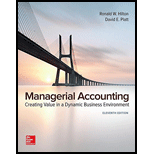
Managerial Accounting: Creating Value in a Dynamic Business Environment
11th Edition
ISBN: 9781259569562
Author: Ronald W Hilton Proffesor Prof, David Platt
Publisher: McGraw-Hill Education
expand_more
expand_more
format_list_bulleted
Concept explainers
Question
Chapter 5, Problem 48P
To determine
Prepare the computation of material handling activity; using the activity based costing system to a friend who is not a business major.
Expert Solution & Answer
Want to see the full answer?
Check out a sample textbook solution
Students have asked these similar questions
Please given correct answer general Accounting
Hii ticher please given correct answer general Accounting
None
Chapter 5 Solutions
Managerial Accounting: Creating Value in a Dynamic Business Environment
Ch. 5 - Briefly explain how a traditional, volume-based...Ch. 5 - Prob. 2RQCh. 5 - Explain how an activity-based costing system...Ch. 5 - What are cost drivers? What is their role in an...Ch. 5 - List and briefly describe the four broad...Ch. 5 - How can an activity-based costing system alleviate...Ch. 5 - Prob. 7RQCh. 5 - How is the distinction between direct and indirect...Ch. 5 - Explain the concept of a pool rate in...Ch. 5 - Briefly explain two factors that tend to result in...
Ch. 5 - List three factors that are important in selecting...Ch. 5 - Prob. 12RQCh. 5 - Explain why a new product-costing system may be...Ch. 5 - Prob. 14RQCh. 5 - Are activity-based costing systems appropriate for...Ch. 5 - Explain why maintaining their medical-services...Ch. 5 - How could the administration at Immunity Medical...Ch. 5 - Prob. 18RQCh. 5 - Prob. 19RQCh. 5 - What is meant by the term activity analysis? Give...Ch. 5 - Prob. 21RQCh. 5 - What is meant by customer-profitability analysis?...Ch. 5 - Explain the relationship between customer profit...Ch. 5 - What is a customer profitability profile?Ch. 5 - Describe the use of practical capacity in a TDABC...Ch. 5 - Tioga Company manufactures sophisticated lenses...Ch. 5 - Urban Elite Cosmetics has used a traditional cost...Ch. 5 - Kentaro Corporation manufactures Digital Video...Ch. 5 - Kentaro Corporation manufactures Digital Video...Ch. 5 - Prob. 31ECh. 5 - Refer to the description given for Wheelco, Inc....Ch. 5 - Prob. 33ECh. 5 - United Technologies Corporation implemented...Ch. 5 - Redwood Company sells craft kits and supplies to...Ch. 5 - Non-value-added costs occur in nonmanufacturing...Ch. 5 - Since you have always wanted to be an...Ch. 5 - Prob. 39ECh. 5 - Prob. 42ECh. 5 - Big Apple Design Company specializes in designing...Ch. 5 - Prob. 44ECh. 5 - Borealis Manufacturing has just completed a major...Ch. 5 - Ontario, Inc. manufactures two products, Standard...Ch. 5 - Kitchen Kings Toledo plant manufactures three...Ch. 5 - Prob. 48PCh. 5 - Maxey Sons manufactures two types of storage...Ch. 5 - Prob. 50PCh. 5 - John Patrick has recently been hired as controller...Ch. 5 - The controller for Tulsa Medical Supply Company...Ch. 5 - Prob. 53PCh. 5 - Prob. 54PCh. 5 - Prob. 55PCh. 5 - World Gourmet Coffee Company (WGCC) is a...Ch. 5 - Knickknack, Inc. manufactures two products: Odds...Ch. 5 - Prob. 58PCh. 5 - Marconi Manufacturing produces two items in its...Ch. 5 - Gigabyte, Inc. manufactures three products for the...Ch. 5 - Refer to the new target prices for Gigabytes three...Ch. 5 - Prob. 62PCh. 5 - Better Bagels, Inc. manufactures a variety of...Ch. 5 - Midwest Home Furnishings Corporation (MHFC)...Ch. 5 - Fresno Fiber Optics, Inc. manufactures fiber optic...Ch. 5 - Refer to the information given in the preceding...Ch. 5 - Whitestone Company produces two subassemblies,...Ch. 5 - Morelli Electric Motor Corporation manufactures...Ch. 5 - Refer to the product costs developed in...Ch. 5 - Morelli Electric Motor Corporations controller,...
Knowledge Booster
Learn more about
Need a deep-dive on the concept behind this application? Look no further. Learn more about this topic, accounting and related others by exploring similar questions and additional content below.Similar questions
- Subject: general Accountingarrow_forwardHow much will you accumulated after 35 year?arrow_forwardOn a particular date, FedEx has a stock price of $89.27 and an EPS of $7.11. Its competitor, UPS, had an EPS of $0.38. What would be the expected price of UPS stock on this date, if estimated using the method of comparables? A) $4.77 B) $7.16 C) $9.54 D) $10.50arrow_forward
arrow_back_ios
SEE MORE QUESTIONS
arrow_forward_ios
Recommended textbooks for you
 Cornerstones of Cost Management (Cornerstones Ser...AccountingISBN:9781305970663Author:Don R. Hansen, Maryanne M. MowenPublisher:Cengage Learning
Cornerstones of Cost Management (Cornerstones Ser...AccountingISBN:9781305970663Author:Don R. Hansen, Maryanne M. MowenPublisher:Cengage Learning Principles of Cost AccountingAccountingISBN:9781305087408Author:Edward J. Vanderbeck, Maria R. MitchellPublisher:Cengage Learning
Principles of Cost AccountingAccountingISBN:9781305087408Author:Edward J. Vanderbeck, Maria R. MitchellPublisher:Cengage Learning Managerial AccountingAccountingISBN:9781337912020Author:Carl Warren, Ph.d. Cma William B. TaylerPublisher:South-Western College Pub
Managerial AccountingAccountingISBN:9781337912020Author:Carl Warren, Ph.d. Cma William B. TaylerPublisher:South-Western College Pub Financial And Managerial AccountingAccountingISBN:9781337902663Author:WARREN, Carl S.Publisher:Cengage Learning,
Financial And Managerial AccountingAccountingISBN:9781337902663Author:WARREN, Carl S.Publisher:Cengage Learning,

Cornerstones of Cost Management (Cornerstones Ser...
Accounting
ISBN:9781305970663
Author:Don R. Hansen, Maryanne M. Mowen
Publisher:Cengage Learning

Principles of Cost Accounting
Accounting
ISBN:9781305087408
Author:Edward J. Vanderbeck, Maria R. Mitchell
Publisher:Cengage Learning

Managerial Accounting
Accounting
ISBN:9781337912020
Author:Carl Warren, Ph.d. Cma William B. Tayler
Publisher:South-Western College Pub

Financial And Managerial Accounting
Accounting
ISBN:9781337902663
Author:WARREN, Carl S.
Publisher:Cengage Learning,
Cost Accounting - Definition, Purpose, Types, How it Works?; Author: WallStreetMojo;https://www.youtube.com/watch?v=AwrwUf8vYEY;License: Standard YouTube License, CC-BY